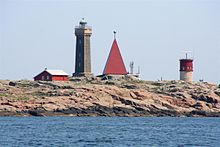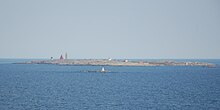Vinga (Gothenburg)
Vinga is an island belonging to Sweden in the Kattegat west of Gothenburg in the province of Västra Götalands län .
location
It is the westernmost island in the Gothenburg archipelago , which is furthest in the sea, west of Gothenburg and belongs to the municipality of Gothenburg . It is only inhabited in summer. The island of Koholmen is only a few meters to the south and the small archipelago of Vinga ungar to the northwest .
The island consists of a porphyrite rock formation and has the shape of a horseshoe open to the west . In the east-west direction it reaches a length of about 1.2 kilometers, in the north-south direction the extension is about 400 meters. Gattulvsviken Bay cuts deep into the island from west to east . On the north side of the bay is the Gattulven peninsula . On the east side of the island there are small bays with Midsommarviken and Drottninghamnen . On the south bank is the port of the island with the Gästhamn. Vinga is not regularly called by Gothenburg's public ferries. However, sea taxis and excursion boats operate from time to time. There is also a possibility to drive from Hönö . In the western part of the southern half is the Vinga lighthouse . The entire island is under nature protection . There is a separate access to the groundwater .
The Gothenburg- Kiel and Gothenburg- Frederikshavn ferry routes pass south-east of Vinga .
history
On Vinga there are traces that indicate that people set foot on the island and caught fish as early as 2000 before the beginning of our era. Since the water level was about 10 meters higher, the northern part of the island should have been separated. It is possible that Vinga belonged to Denmark at times in the past . In addition to Swedish inscriptions, there are also Danish inscriptions on the island.
The erection of a beacon on Vinga as a sea mark is documented for the year 1606 . In the middle of the 17th century a house was built on Vinga. Vinga became the location for Gothenburg's pilots . At first there was a lighthouse on Vinga, later a second was built. The towers were manned around the clock. The lighthouse keepers, their families and assistants lived on the island. The population reached a size that required the building of a school. However, there was no agriculture or commercial fishing. Earth was brought in from Brännö so that small gardens and fields could be created on Vinga for self-sufficiency. Domestic animals such as chickens and cows were also kept.
From 1890 to 1905, Evert Taube (1890–1976) , who later became known as an important author and composer, lived on Vinga as the son of a lighthouse keeper. About 40 people lived on Vinga during this period.
Until the middle of the 20th century, the navigation marks were still operated by hand.
Facilities
In Vinga, the Winga Vänner Association, founded in 1984, created two museums. One is in the pyramid-shaped beacon built in 1857 and deals with the history of the Vingas lighthouses. A museum has been set up in the former home of the lighthouse keeper, which deals thematically with Evert Taube and the history of the island. There are two holiday homes on the island that can be rented out during the summer months, as well as a kiosk. The island's port is a popular destination for private ships.
Web links
- Information about Venga on the website of goteborg-online.com
- Homepage of the Winga Vänner Association (Swedish)
- private information about Venga
Coordinates: 57 ° 38 ' N , 11 ° 36' E


